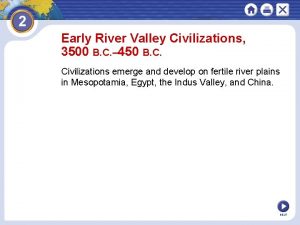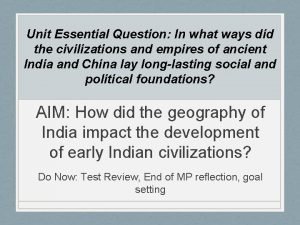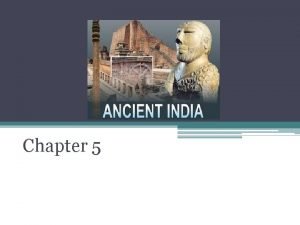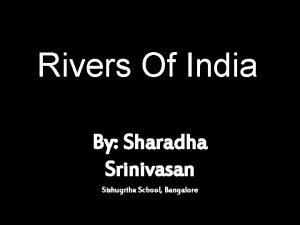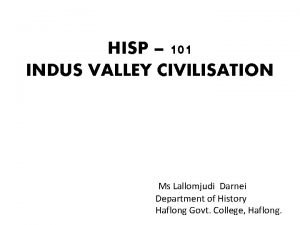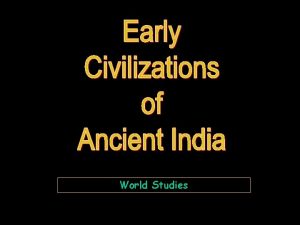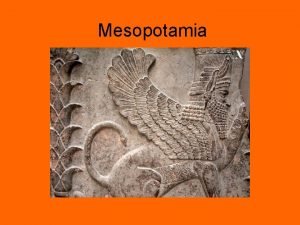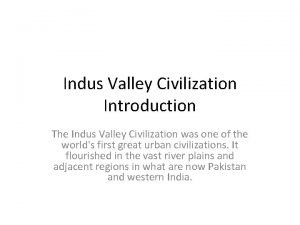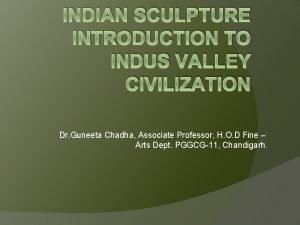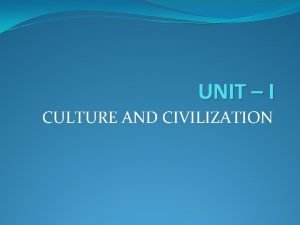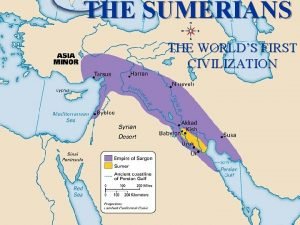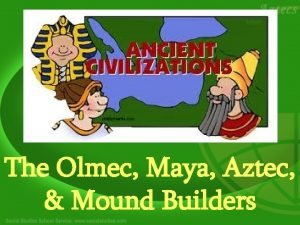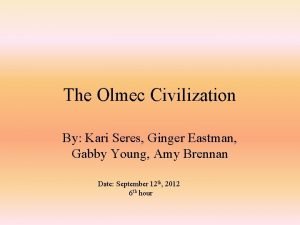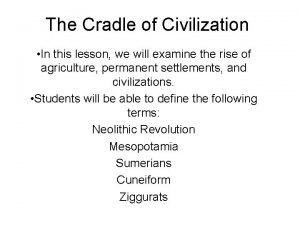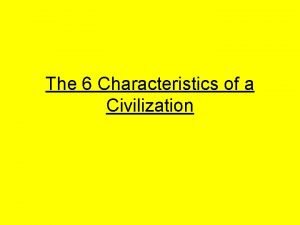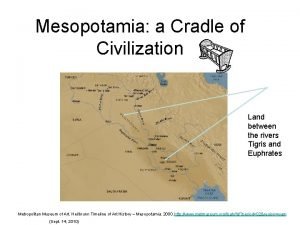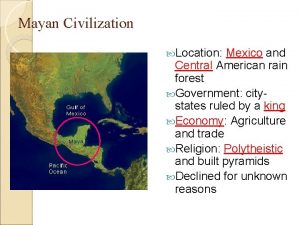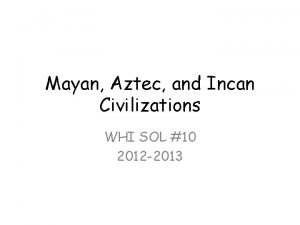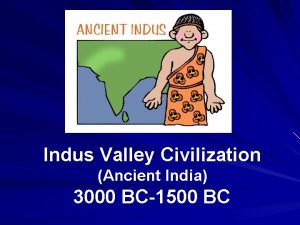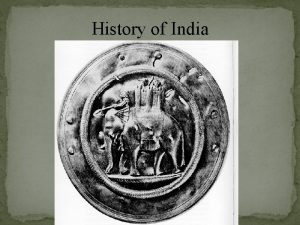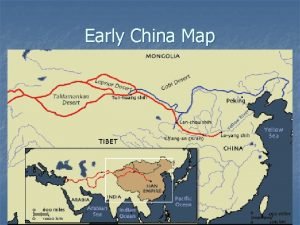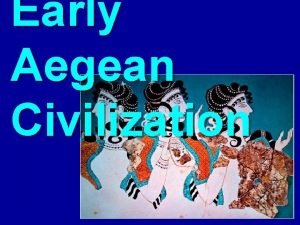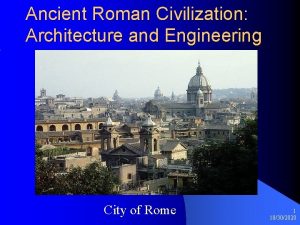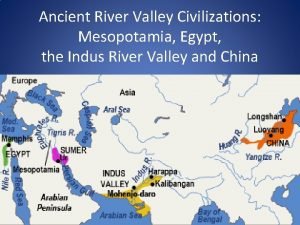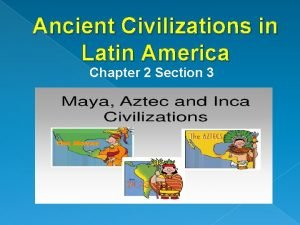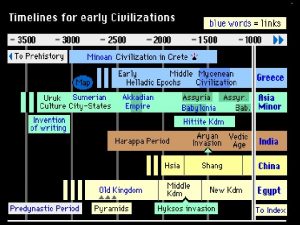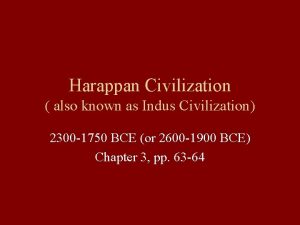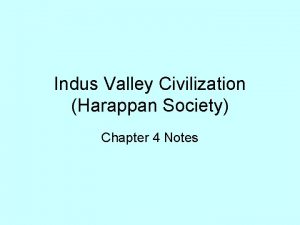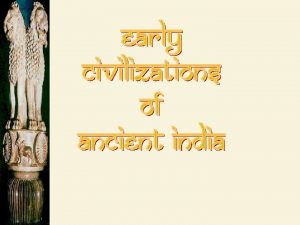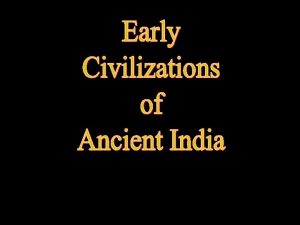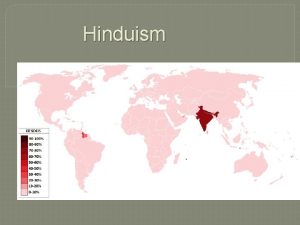HARAPPAN CIVILIZATION CHAPTER1 HARAPPAN CIVILIZATION Introduction This civilization























































- Slides: 55

HARAPPAN CIVILIZATION

CHAPTER-1 HARAPPAN CIVILIZATION Introduction: This civilization is known by different names such as the Indus Valley Civilization or the Harappan Civilization because the first site of this civilization was discovered from Harappa. This is also known as Chalcolithic and Bronze Age Civilization. MAIN FEATURES: Ø The oldest living civilization in the world Ø Also known as Indus Valley or Chaleolithic and Bronze Age civilization

HARAPPAN CIVILIZATION Ø Well planned cities, wide roads and lanes Ø Highly efficient sanitation and drainage system Ø Provision for lighting on the roadside Ø Use of baked bricks

SOCIAL AND ECONOMIC LIFE Ø Joint family system, No caste system Ø Pictographic script Ø Position of women seemed to be pretty good Ø Ornaments were made of gold, silver and precious stones Ø Knowledge of Ayurvedic medicines Ø Agriculture was the main occupation Ø Domestication of animals Ø Trade relations with Foreign Countries Ø Barter System, Use of weight and measures

CHAPTER-2 VEDIC AGE Introduction : The Vedic Period or the Vedic Age refers to that time period when the Vedic Sanskrit text were composed in India. The society that emerged during that time is known as the Vedic Age Civilization. MAIN FEATURES: Ø It flourished between 1500 B. C. - 500 B. C. on the Indo. Gangetic plains of India Ø It laid the foundation of Hinduism Ø Veda means Knowledge. It is a collection of hymns, prayers, charms and sacrificial formulae Ø 4 Vedas- Rig Veda, Sam Veda, Yajur Veda, Atharva Veda

SOCIAL AND ECONOMIC LIFE Ø Patriarchal form of family Ø Position of women very respectable and honourable, Monogamy prevalent Ø Caste system based on occupation Ø 4 Ashrams of life- Brahmcharya, Grihastha, Vanaprastha, Sanyas Ø Optimistic about life Ø Education provided for character building Ø Agriculture was the main occupation Ø Domestication of animals Ø Trade Guilds/ Profession Guilds Ø Knowledge of metals- Gold, Silver, Copper, Iron Ø Nature of civilization was rural

CHAPTER-3 RELIGION- VEDIC, IMPACT OF BUDDHISM AND JAINISM Introduction: Ancient religion of India that was contemporary with the composition of the Vedas and was the precursor of Hinduism is called Vedic religion. The sixth century B. C. witnessed the rise of two religious sects in India Buddhism and Jainism founded by two Kshatriya princes, Buddhism by Gautam Buddha and Jainism by Vardhman Mahavira.

MAIN FEATURES OF VEDIC RELIGION: Ø Vedic religion was the precursor of Hinduism Ø Indo-Aryans in the Sapt-Sindhu region followed Vedic religion Ø Worship of numerous male divinites connected with the sky and natural phenomena Ø Ceremonies centred on ritual sacrifice of animals Ø Use of soma Ø Concepts of atman, brahman, reincarnation, karma Ø The 4 vedas contain the essence of Vedic religion

IMPACT OF BUDDHISM: Ø Caste system was weakened Ø Concept of Universal Brotherhood promoted Ø Works of public welfare Ø Relations with foreign countries Ø Spirit of non- violence Ø Atmosphere of peace and love Ø Development in literature

IMPACT OF JAINISM: Ø A great blow to Caste System Ø Impetus to work of public welfare Ø Spirit of Ethics in the family developed Ø Emancipation of women Ø Reform in Hinduism Ø End of supremacy of the Brahmins Ø Compassion for men and beasts Ø Development of the spirit of peace Ø Demoralizing influence on fighting spirit of army

Chapter 4 SOCIETY AND CULTURE C. 1000 A. D. Introduction : After Harsha’s death in 647 A. D. there prevailed complete anarchy, disorder and chaos in the country. The Hindu and Rajput rulers failed to give a stable government to the country. The result was that they all succumbed before the Muslim invaders one by one which proved very harmful and costly for India.

Main features of social life: Ø Caste system created sharp differences in society and thus weakened the society Ø Deterioration of the position of women Ø Emergence of Feudalism Ø Narrow mindedness developed in people Ø Kshatriyas alone defended the country Ø Lack of spirit of brotherhood Ø Social evils in society

Main Features of Economic Life Ø Self-Sufficient village economy Ø Economic Stagnation Ø Intermediary taxes Ø Decline of Trade and Commerce Ø Decline of Guilds Ø Emergence of the class of moneylenders Ø Huge disparity between rich and poor

Main Features of Religious Life Ø Revival of Hinduism Ø Deterioration of religion and morality Ø System of Devadasis Ø No unity in the religious sphere Ø Higher classes lived in luxury Ø Effects of the Vammarga Dharma Ø Development of Tantrik Literature

Cultural Life and Education Ø Development of Art and Culture Ø Presence of Universities Ø Rise of pathshalas Ø Decline of education system Ø Lack of female education

CHAPTER-5 CULTURAL REORIENTATION: BHAKTI AND SUFISM Introduction : During the medieval period, Hinduism witnessed a great and silent revival through the rise of bhakti movement. With the Muslim invasion Sufis entered Punjab and started preaching here. These movement laid particular emphasis on devotion and surrender to God as the best way to attain salvation.

Bhakti Movement- Causes of Origin: Ø Defects in Hinduism Ø The danger of Islam to Hinduism Ø Birth of great social reformers Ø Permanent settlement of Muslims in India Ø Birth of Sufi Saints Ø Inter- mingling of Hindus and Muslims

Main Features of Bhakti Movement: Ø Unity of God, Significance of God Ø Intense love and devotion to God Ø Faith in Spiritual guide or Guru Ø Stress on noble and good deeds Ø Self surrender to the Will of God Ø No belief in caste system Ø No belief in Idol worship Ø Attack on ritualism and false practices Ø No sanctity of any particular language

Effects of Bhakti Movement Ø Protection of Hinduism Ø A great blow to the influence of the Brahmins Ø A great setback to Buddhism Ø Checked the progress of Islam Ø Birth and growth of Sikhism Ø Fostered sympathy, love and brotherhood in Hindu society Ø Led to co- operation between Hindus and Muslims Ø Flexibility in the caste system

Main features of Sufi Movement • Sufi was derived from the word “Safa” which means pure or Arabic word “Sooph” which means wool • Sufism was divided into two parts: – Ba-sar : Those who attached importance to Islamic laws. – Be-sara : Those who did not believe in Islamic laws.

Main features of Sufi Movement ØThe sufi were organised in 12 Orders or Silsilas like Chisti, Suhrawardi, Firdausi, Naqashbandi etc. ØMain features of Sufism ØGod is One ØFaith in Spiritual Guide-Guru (Pir) ØSelf Surrender or ‘Prapti’ ØBelief in different School of Sufism ØPreaching in Arabic , Persian, and Urdu ØEmphasis on Devotional music and songs

Chapter 6 Society and Culture c. 1500 A. D. • Introduction : The Indian Society in Punjab during the Afghan rule was divided into two major sections : (a) Muslim Society (b) Hindu Society. Of the two, the Muslims were the favourite children of the state because they belonged to the ruling class and the latter were the ruled section of the population. The Hindus were considered as the second rate citizens and were treated with indifference and disdain.

• Society and Culture • Social position of the muslims – Foreign Muslim formed the rulling class which was the most previleged and respected section of the Society. – Indian Muslim were considered as low born and were despised by foreign muslims

ØDrawbacks of the Muslim Society • The Slave System • Drinking and Gambling • Illiteracy , Ignorance and Superstitions • Position of Women was far from being satisfactory as they suffered from many social evils.

ØSocial Conditions of the Hindus § Professions of Hindus were mainly Trade and Agriculture § Sea-Change in the character of Hindu population § Loss of traditional patronage of Brahamanas § Caste System among the Hindus § Position of Hindu Women in the Society was miserable and pitiable.

Ø Religious Beliefs and Practices • Hinduism- Shaivism , Vaishnavism and Shaktism • Rise of Bhakti and Sufi Saints • New converts to Muslim faith • Decline in the Status of Brahmanas • Decline of Buddhism • Rise of Punjabi and Urdu • Setback to Hindu Art

Chapter 7 Shikhism Ø Introduction : Guru Nanak was one of the greatest religious innovators all time and the founder of the Sikh religion. The origins of Sikhism may be traced to a part of Punjab which is located modern day Pakistan where the Sikhism faith originated with Guru Nanak Dev in the early 1500’s.

Shikhism Ø Guru Nanak Dev § Early life of Guru Nanak Dev § Teachings of Guru Nanak Dev § Conception of God ü God is One üGod is Omnipotent üGod is formless üGod is Merciful üGod is Self-Created

Shikhism § Emphasis on the true name of God § The place of Guru in the realization of God § Emphasis on Ideal Family Life § No belief in Ideal Worship § No belief in Caste System § Belief in the Equality of Mankind § Emphasis on the Social Services § Faith in theory of Karma § Emphasis on Morality

Shikhism Ø Contribution of Guru Arjun Dev • Introduction of Gurumukhi Alphabet • Extension of Langar System • Compilation and Composition of Janam Sakhi • Foundation of Goindwal • Fostered and Maintained Complete discipline Ø Contribution of Guru Amar Das • Construction of Baoli at Goindwal

Shikhism • Compilation and Composition of Guru Bani • Social reform by Guru Amar Das ü Attack on Caste System and Untouchability ü Emphasis on Inter Caste Marriages ü Widow Marriage ü Abolition of Sati and Parda ü Against the use of Intoxicants ü Preaching the teachings in Punjabi ü New Mode of celebrating Festivals ü Akbar’s Meeting with the Guru at Goindwal

Shikhism Ø Contribution of Guru Ram Das • Laid the foundation of Ramdaspura or Amritsar • Masand System was started by Guru Ram Das • Propagation and spread of Sikhism • Establishment of friendly and cordial relations with Akbar • Nomination of Arjan Dev as his successor – a wise step

Chapter 8 Transformation of Sikhism Ø Introduction : Guru Arjan Dev was martyred in 1606 A. D. by the orders of the Mughal emperor Jahangir. Guru Teg Bahadur was executed in 1675 A. D. at the order of Aurangzeb. The martyrdom of both Gurus occupies an important place in the history of Sikh religion and transformation of Sikhism.

Ø Martyrdom of Guru Arjan Dev : Causes and Impact Ø Causes : • Allegation to create a state within Mugal Empire • Religious Fanaticism of Jahangir • Arjan Dev’s alleged help to Prince Khusro • Intrigues and animosity of Chandu Shah • Enimity and opposition of Prithia • Guru’s refusal to pay the fine of 2 Lac Rupees

Shikhism Ø Impacts : • Transformed the Sikhs from religious devotees to Saint- Soldiers • Enmity between Sikhs and the Mugals • Atrocities and tyrannies on the Sikhs • New Policy of Guru Hargobind • It fostered unity amonst the Sikhs • It sat the tradition of self-sacrifice • It made Sikhism popular

Ø Martyrdom of Guru Teg Bahadur : Causes and Impacts Ø Causes : • Increasing hostility between the Sikhs and the Mughals • Fanaticism of Aurangzeb • Religious activities and increasing popularity of Guru • Rivalry of Ram Rai • Impact of Nakshbandis on Aurangzeb

Chapter 9 Institution of Khalsa Ø Introduction : The foundation of Khalsa in 1699 A. D. by Guru Gobind Singh was an event of paramount importance not only in the history of Sikhism but also in the history of India. This was the most laudable achievement of the Guru and shows his organizing prowess. Ø

Shikhism Ø Causes of the Foundation of Khalsa • Need for a powerful organization to combat Mughal tyranny • Works and doctrines as propagated by the first nine Sikh Gurus • Religious intolerance of Aurangzeb • Submissive attitude of the Hill-Rajas towards the Mughals

Shikhism • • • The deterioration condition of the Sikh Panth Degeneration of the institution of the Masands Shackles of the Caste System Nature of the Jats Necessity for a New Organization Desire to fulfil a mission

Shikhism Ø Significance of the creation of the Khalsa • Increase in the number of followers of the Guru • Creation of a race of saint-soldiers • Greatest Social Revolution • The Khalsa was purified of superstitions and blind-faith • It gave a new life to the depressed and downtrodden people

• Democratic Teachings • It made Sikhism distinct from Hinduism • It fostered the feelings of unity amongst the Sikh community • It resulted into war between the Guru and the hill-chief • The Khalsa saved Hinduism from destruction • End of the Masand System • It increased the importance of Jats • Attainment of Political Power • It completed the work started by Guru Nanak Dev

Chapter 10 Changes in Society : Social Unrest, Rakhi System, Gurmatta, Dal Khalsa Ø Introduction : After the period of ten Gurus, the Sikhs had the fortune of having saint soldier leaders to guide the destinies of the Sikh people. These leaders were spiritually intoxicated and had undeterring faith in God and the teachings of the Gurus. They were idal examples of the Khalsa the saint-soldiers created by the tenth Guru.

Ø Dal Khalsa • Dal khalsa was established by Kapur Singh. • After the death of Banda Bahadur Singh in 1716 Sikhs organized themselves in 65 jathas because they were ruthlessly killed and suppressed by Mughal governor of Punjab. •

Changes in Society : Social Unrest, Rakhi System, Gurmatta, Dal Khalsa Ø Rakhi System • The ‘Rakhi System’ evolved in 1753 A. D. • Rakhi means protection from within as well as from outside. • People were suffring due to anarchical rule of Lahore Government and repeated invasion of Afgan ruler of Ahmad Shah Abdali. • Under ‘Rakhi System’ a protection was granted by ‘Dal Khalsa’ against the exploitation by Zamindars, oppressive Mughal officers, Afgans and the robbers. • In return, Misl Chiefs took one fifth of the revenue of the village, twice a year, after each harvest.

Ø Gurmatta • The word Gurmatta means the advice of the spiritual Guru. • Gurmatta was the central body of the Sikhs which came into existence after the death of Guru Gobind Singh. • The Sikhs gathered at Amritsar at the time of Diwali and Baisakhi to discuss the common plan of action for the entire Sikh community. These meetings of the entire body of Sikh were called ‘Sarbat Khalsa’.

• The decisions or the resolutions passed in the presence of the Holy Granth Sahib by the Sarbat Khalsa were called Gurmatta. • With the passage of time, these meetings of Sarbat Khalsa assumed the shape of a definite organization and this central organization of the Sikh Misls came to be addressed as Gurmatta.

• Under Kapur singh leadership these 65 jathas were organized themselves into 12 Misls to fight common enemy Mughal governor and Afgan ruler Ahmad Shah Abdali. • Kapur Singh merged the fighting bands of the 12 Sikh Misls into one united Dal and names it as the ‘Dal Khalsa’. • After the Death of Kapur Singh Jassa Singh Ahluwalia became leader of ‘Dal khalsa’.

Ø Functions of the Gurmatta : • It elected the leader of the Dal Khalsa. • It took decisions on the foreign policy of the Sikhs. • It tried to resolve the rivalry between the Sikhs. • It took decisions for the administration of the Gurdwaras. • It Discussed plans for military actions against their enemies.

Chapter 11 Society and Culture under Maharaja Ranjit Singh Ø Introduction : Maharaja Ranjit Singh also called Sher-e-Punjab was the founder of the Sikh rule in Punjab. He was endowed with the finest traits of humanity and utilized them for welfare of his subjects. Social condition under Maharaja Ranjit Singh • Status of the people of the punjab • Position of women the society was not satisfactory.

• Food of the people of punjab was wheat or rice, milk fruits vegetables. They wore kurta, pyjama, and turban. • System of beggary also existed. • The System of Sati was also prevalent in the society. • Laws of Succession pertaining to property were differed from place to place. • Hospitality and charity among the Hindus, Muslims

Ø Economic conditions • Agriculture was main occupation of the people. • Cloths, weapons, leather goods, shawls etc. industries were also established. • The main means of transporting goods were camels, ponies, donkeys and boats. • Land revenue policy : Batai system continued upto 1823 A. D. , and in 1824 Kankut system was introduced. Ø Religious condition • Maharaja Ranjit Singh a religiously tolerant king • Liberal grants to the Hindus , Muslims , Sikhs & others • Participations in the religious festivals of all religions

Ø Development of Architecture • specimen of architecture during this period is the “Ram Bagh Garden” in Amritsar with its royal palaces and gates, gardens, watching towers and “ Baran Dari”. • Another site is the Gobindgarh fort of Maharaja. Ø Paintings Ø Coins and Numismatics • Nanak Shahi, Akal Shahi were coins. Ø

Ø Literature • “Gulgasht-i-Punjab” • “Iqbalnama-i-Maharaja Ranjit Singh” • “Tankh-i-kalan Kashmir” • “Zafarnama” • Arms and Armour

Chapter 12 Major Historical Places of Punjab Ø Introduction: In this chapter 12 Major Historical Places of Punjab have been given. Ø Mohanjodaro Ø Harappa Ø Sanghol Ø Amritsar Ø Anandpur Sahib

Major Historical Places of Punjab Ø Tarn Taran Ø Kiratpur Ø Ropar Ø Machhiwara Ø Khandur Sahib Ø Goindwal Ø Lahore
 Introduction of indus valley civilization
Introduction of indus valley civilization Of mice and men chapter1
Of mice and men chapter1 Burnished bronze feet
Burnished bronze feet Pin 2 dmd
Pin 2 dmd Indus valley economy
Indus valley economy Drainage system in harappan civilization
Drainage system in harappan civilization Map of harappa
Map of harappa Indus valley civilization education
Indus valley civilization education Top of the caste system
Top of the caste system Project on harappan civilization
Project on harappan civilization Under 70
Under 70 Conclusion of indus valley civilization
Conclusion of indus valley civilization Selyong harappan
Selyong harappan Harappan pottery
Harappan pottery Mesopotamian civilization conclusion
Mesopotamian civilization conclusion Introduction to mesopotamian civilization
Introduction to mesopotamian civilization Introduction to indus valley civilization
Introduction to indus valley civilization Introduction about indus valley civilization
Introduction about indus valley civilization Mount olympus
Mount olympus Intro paragraph layout
Intro paragraph layout Sumerian
Sumerian Where is aztec located
Where is aztec located Taylor culture
Taylor culture When did the first civilization start
When did the first civilization start What are the seven features of civilization
What are the seven features of civilization Olmec glyphs
Olmec glyphs Olmec map
Olmec map Cyclades civilization
Cyclades civilization The cradle of civilization
The cradle of civilization Aegean civilization architecture
Aegean civilization architecture The 6 characteristics of civilization
The 6 characteristics of civilization Obsolescent frontier civilization diagram
Obsolescent frontier civilization diagram Sumer river
Sumer river Cradles of civilization map
Cradles of civilization map Civilization time period
Civilization time period Medicine in ancient india
Medicine in ancient india Mayan civilization location
Mayan civilization location What does this drawing indicate about the inca civilization
What does this drawing indicate about the inca civilization Aztec inca maya map
Aztec inca maya map Differentiate obsolescent “frontier” civilization
Differentiate obsolescent “frontier” civilization Aryan civilization
Aryan civilization Hwang ho river civilization
Hwang ho river civilization Indus valley civilization trade and economy
Indus valley civilization trade and economy Chapter 8 lesson 1 greek culture
Chapter 8 lesson 1 greek culture Early china map
Early china map Aegean civilization
Aegean civilization Defination of civilization
Defination of civilization Create your own civilization
Create your own civilization Olmec civilization
Olmec civilization Characteristics of civilization
Characteristics of civilization Chapter 8 lesson 2 the greek mind
Chapter 8 lesson 2 the greek mind Where is the minoan civilization located
Where is the minoan civilization located Roman civilization architecture
Roman civilization architecture River valley civilization map
River valley civilization map Maya aztec and inca civilization chart answers
Maya aztec and inca civilization chart answers Discovery civilization channel
Discovery civilization channel





